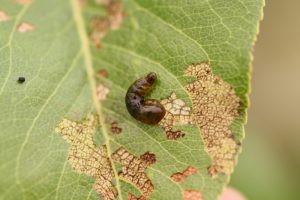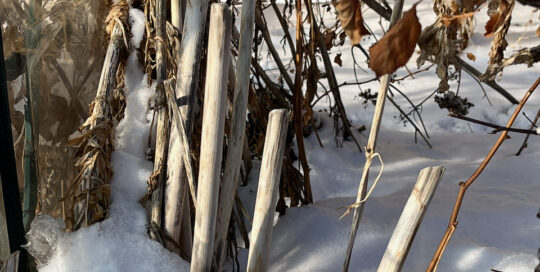Not So Peachy Pear Slugs
Views: 3493

This morning my husband noticed odd little slug looking things on the pear leaves.
At first glance, I wondered if a flock of sparrows perched on the branches, since it resembled little bits of bird poo. But the damage to the outer layer of the leaves was obvious, so it’s plain that these were some sort of pest.
What are pear slugs?
It turns out these are called, fittingly enough, pear slugs. But they’re not slugs. They’re actually the larvae of the sawfly, a tiny (as in less than a ¼ inch long) wasp that looks like a fly. I can’t say that I’ve seen a sawfly, but I’m amazed at the number of the larva on the pear tree.
The sawfly overwinter as pupa in the ground, then emerge as adults in the spring. Later in the season, the sawfly females lay eggs in a slit in the leaf of a plant. After they larva emerge, they feed on the leaves until they ultimately drop down to pupate in the soil to start the cycle again. Many areas will have 2 generations per season with the second one being faster (and sometimes greater numbers) due to the warmer soil temperature. That’s what we’re seeing now on our tree.
What to do
Some people may opt to leave pear slugs alone, because some feeding won’t necessarily damage the tree, and it’s not going to be that long until the leaves drop and the season ends. And since the sawfly pupa really aren’t that durable, particularly when it comes to bitter cold temperatures, leaving them alone probably won’t mean we’ll have epic levels next season.
But, because the Farmers’ Almanac is forecasting a bitterly cold winter for us, and I want to ensure our trees are going into the season as healthy as possible, I will kill them. They’re pretty wimpy little things, so thankfully it won’t be difficult. I’ll blast them with the hose, or if that doesn’t do the trick, dust them with diatomaceous earth. At the worst case scenario, having to break out the insecticidal soap is as strong as you should have to go.
For those who have a serious infestation, because they will chew on other fruit trees and ornamentals, cultivate below your plants in the fall to kill the pupa. By disturbing the soil, you’re bringing them closer to the surface where they won’t survive.
Although seeing the larva on the leaves was a little alarming at first, at least pear slugs aren’t a terrible nuisance, nor are they that difficult to manage on the trees. And now that I know what they look like, and where they like to feed, I’ll be sure to examine my other trees and shrubs so I can eliminate any others before autumn to keep the plants healthy.
Meet Amy Grisak
Amy is a freelance author and photographer in Great Falls, MT who specializes in gardening, foods, and sustainable agriculture. She provides information on every kind…
Amy's Recent Posts

This Little Piggy is a Problem: Dealing with Feral Hogs








